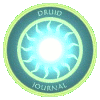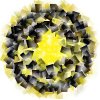What does fiction have to do with divination?
The common thread is the story structure, the plot. A work of fiction is an illustration of prototypical event structures, plotlines that are moving or meaningful. A divination system also provides plotlines, as well as general elements to flesh out the events of the story. A divination system shows you a possible plot line for your own personal story; it allows you to construct a tale to make sense of your life.

A Tarot spread can be thought of as a narrative structure upon which you can hang the life events surrounding the theme of your reading. The classic three-card reading — past, present, future — is just about as basic a narrative structure as one can imagine. The Celtic Cross is an elaboration of that basic narrative, showing obstacles, influences from ‘above’ and ‘below’, etc. Diane Sylvan has a marvelous spread (the Storyteller) that echoes Campbell’s journey of the hero. The Tetractys spread, which I learned of while researching this article, is a fascinating one that I’d love to try sometime, and seems to combine four plot patterns into one.
The Tolkien spread uses Tolkien’s favorite six-part plot pattern, which I explain in detail in the previous post; it underlies most of the action of The Lord of the Rings, as well as the overall arc of the novel itself. It illustrates Tolkien’s primary theme, eucatastrophe — the sudden twist, unexpected and yet intimately bound up with the framework of the tale, that brings the story to a positive conclusion.
I’ve named the cards after some examples from the novel.
- Bag End. The source; the starting situation. Indicates the state of equilibrium that is broken when the journey commences. Examples of ‘Bag End’ include Tom Bombadil’s house, Rivendell, Lorien, Faramir’s hideout, and of course, Bag End itself.
- The Fellowship. The journey — difficulties encountered, or friends that step in to help. The process of learning that is necessary to carry the Querent through to the end. The difficulties that require fortitude, strength, and faith.
- Gandalf. The guiding spirit of the journey, which places unexpected resources in the path in the form of apparent happenstance.
- Cirith Ungol. The terrible peril; the primary difficulty of the journey. Here, nearly all hope may be lost; no way forward may be seen. It may also represent an alternative ending place, if the Querent so chooses, although this may not be advisable.
- Gollum. The eucatastrophe: the sudden, unexpected twist that resolves the situation. May represent a new way of viewing the affair, or the prominence of a new factor that was unconsidered before.
- Grey Havens. The ending situation; the new equilibrium after the resolution. Of course, in Tolkien’s vision, all new situations are colored with sorrow, because the old equilibrium (Bag End) has been lost forever.
Notice that if you use this spread, you’re really committing yourself to this kind of plot — the journey, the guiding spirit, the surprise ending. If this isn’t the kind of story you want to tell, you’d best use a different spread! But I suspect this spread would be very useful for certain kinds of situations — ones where perhaps you feel helpless, out of your depth, or trapped with no apparent way out. In such a situation, you may want to find a story you can tell that highlights guidance from Spirit through difficult times.
An Illustration: Balancing Home, Work, and Spirit
I’m a little hesitant to give this illustration, since I’m in the midst of trying to work this situation out for myself; I don’t know what the answers are yet, and I may not be able to tie everything up in a nice rhetorical bow at the end. Nevertheless, I’m excited to try this spread, since I feel like I’m right in the middle of a helpless, trapped, out-of-my-depth situation.
Put simply, I have been trying to find some way to bring my scattered energies into one unified place. I spend time at work, I spend time with my family, and (sometimes) I spend time on druidism and this site, but they feel to me to be in conflict with each other, competing for my time, rather than working together coherently and reinforcing each other. I can’t drop any of them; they’ve got to learn to live together. I’ve been working with this problem for years, and the stresses and conflicts have only gotten stronger.
Here are the cards of the spread, along with some off-the-cuff thoughts:
- Bag End: 10 Pentacles (Wealth). A fitting starting place, since each of the three areas of my life are, separately, going pretty well. But the 10’s aspect of completion is appropriate, since they’ve each separately grown successful enough to interfere with each other, and they can no longer grow without doing so at each other’s expense.
- The Fellowship: The Star, reversed. Lost hopes, false hopes, doubt, failure; desperation. This is definitely a reflection of the difficulties I’m having on this journey.
- Gandalf: Justice, reversed. Imbalance, injustice, disharmony. I’m not sure of the best way to read this, since ‘Gandalf’ is supposed to be the positive influence of guiding Spirit; but one meaning that comes to mind is that Spirit is actively keeping the elements unbalanced and in conflict, in order to achieve some larger end. The more I think about it, the more likely this appears to me.
- Cirith Ungol: 10 Swords (Ruin). A fitting card for the Terrible Peril. Crushing, merciless defeat, brought about by too much emphasis on intellect divorced from reality. Ouchie.
- Gollum: King of Swords. Isn’t this something? The Ruin of the 10 Swords is reversed and redeemed by the King of Swords — by intellect grounded in reality. This is an excellent illustration of eucatastrophe: an unexpected, wonderful reversal of fortune brought about by elements from the existing framework of the story.
- The Grey Havens: Ace of Pentacles (reversed). An obvious tie-in back to Bag End’s 10 Pentacles, which reflects the dual nature of the Grey Havens — looking both forward and back. And the implications of the Swords — that the relationship between the intellect and reality needs work — is reflected in the relationship between Swords and Pentacles. The fact that it’s the Ace could indicate a brand new beginning… The cycle represented by the 10 is over, and a wholly new path is opening. (The reversal is a bit worrying, though.)
Working to make sense of your life — whether events that have already passed, or situations you’re in the midst of — is an act of storytelling, placing a structure on events to give them meaning. Recognizing the structures you’re using will not only give you more control over the stories you construct, they’ll allow you to recognize your true role in your life: not Victim, not Victor, not Bystander or Schemer or Lover or Savior, but Author.






Leave a comment